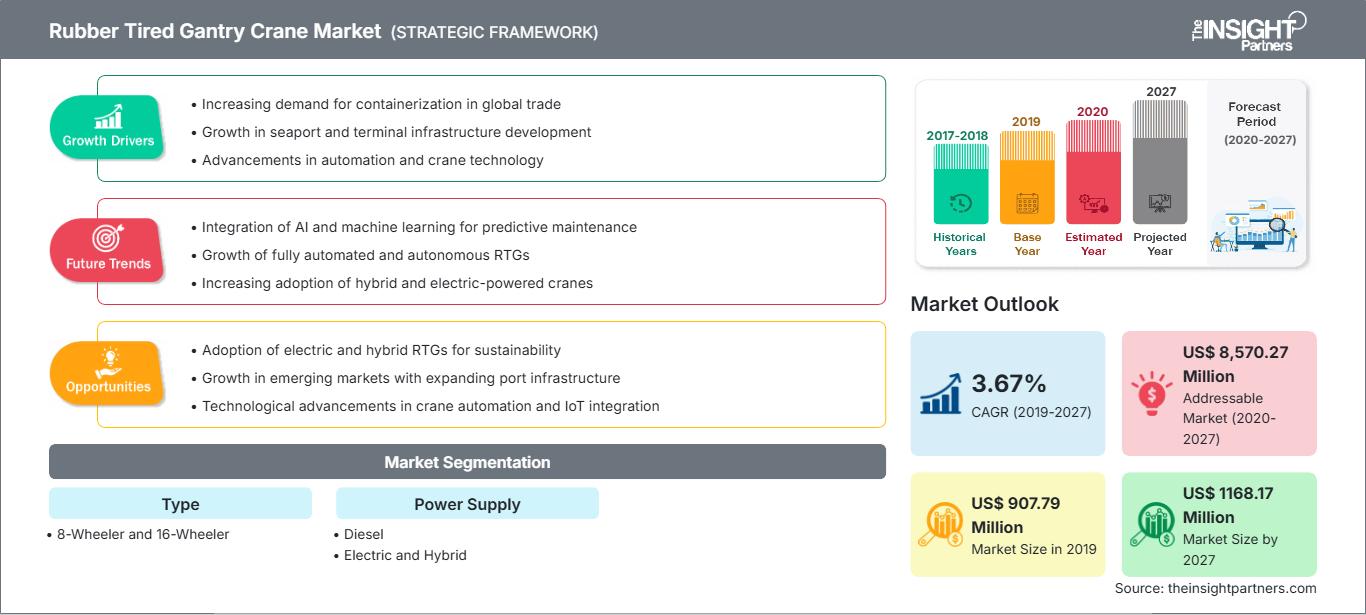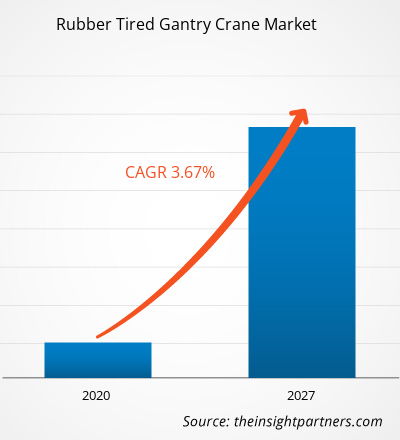Der Markt für Portalkräne mit Gummireifen wurde 2019 auf 907,79 Millionen USD geschätzt und soll bis 2027 1168,17 Millionen USD erreichen; von 2020 bis 2027 wird ein CAGR-Wachstum von 3,67 % erwartet.
Früher waren Entwicklungsländer Rohstofflieferanten; die Handelsstruktur hat ihnen jedoch weltweit eine neue Rolle zugewiesen, wodurch der Markt für Portalkräne mit Gummireifen im Prognosezeitraum voraussichtlich ein deutliches Wachstum verzeichnen wird. Das Marktwachstum ist hauptsächlich auf die steigende Nachfrage nach Seehandel zurückzuführen, da Entwicklungsländer, darunter China, zu wichtigen Importeuren und Exporteuren von Gütern auf dem Seeweg werden, wobei Asien die größte Handelsregion ist.
Darüber hinaus wird der Markt für Portalkräne mit Gummireifen durch günstige staatliche Initiativen zur Entwicklung von Häfen vorangetrieben. Ein Hafen wird zu einem Motor der Wirtschaft, wenn er reibungslos funktioniert. Heutzutage ist der Zweck eines Hafens nicht mehr nur begrenzt, sondern wird zunehmend auch als logistische Plattform genutzt. Die Produktivität eines Hafens ist für den internationalen Handel wichtig, da ein Seehafen die Drehscheibe des Außenhandels eines Landes ist. Verschiedene Regierungsmaßnahmen werden den globalen Markt für gummibereifte Portalkrane im Prognosezeitraum ankurbeln.
Europa war 2019 Marktführer für gummibereifte Portalkrane und wird seine Dominanz voraussichtlich auch im Prognosezeitraum beibehalten. Europas Häfen haben elektrische RTGs eingeführt, um Umweltverschmutzung und Treibhausgasemissionen zu reduzieren. Staatliche Vorschriften in dieser Region haben den Einsatz elektrischer Containerumschlaggeräte ermöglicht, beispielsweise zur Überprüfung der CO2-Emissionen im Seeverkehr. Europa verzeichnet ein großes Handelsvolumen mit Produkten und Vermögenswerten wie Maschinen, Fahrzeugen, Flugzeugen, Kraftstoffen, Nichteisenmetallen, Textilien, Chemikalien, Kleidung und Rohöl. Europa ist führend im Handel und damit führend auf dem Weltmarkt für gummibereifte Portalkrane.
Passen Sie diesen Bericht Ihren Anforderungen an
Sie erhalten kostenlos Anpassungen an jedem Bericht, einschließlich Teilen dieses Berichts oder einer Analyse auf Länderebene, eines Excel-Datenpakets sowie tolle Angebote und Rabatte für Start-ups und Universitäten.
Markt für Portalkräne mit Gummireifen: Strategische Einblicke

-
Holen Sie sich die wichtigsten Markttrends aus diesem Bericht.Dieses KOSTENLOSE Beispiel umfasst Datenanalysen, die von Markttrends bis hin zu Schätzungen und Prognosen reichen.
Die COVID-19-Krise wirkt sich auf Branchen weltweit aus, und die Weltwirtschaft wird voraussichtlich sowohl 2020 als auch 2021 am stärksten betroffen sein. Der Ausbruch hat zu erheblichen Störungen in Schlüsselindustrien wie Unterhaltungselektronik, Halbleiterindustrie, Automobilindustrie und IT-Infrastruktur geführt. Alle diese Branchen sind für das Wachstum des globalen Marktes für Portalkräne mit Gummireifen von entscheidender Bedeutung, da sie die größte Nachfrage nach Portalkränen mit Gummireifen erzeugen. Fabrikschließungen, Reiseverbote, Handelsverbote und Grenzsperrungen haben sich sowohl auf die Herstellung als auch auf den Verkauf verschiedener Produkte und Komponenten der Unterhaltungselektronik ausgewirkt. Die globale Elektronik- und Halbleiterindustrie ist eine der wichtigsten Branchen, die aufgrund von Lieferkettenproblemen und Produktionsstillständen mit ernsthaften Störungen konfrontiert ist.
Markteinblicke: Steigender Fokus auf grüne Technologien
teilnehmer konzentrieren sich aufgrund strenger staatlicher Vorschriften zu Schadstoff- und Emissionsgrenzwerten in verschiedenen Regionen auf grüne Technologien. Auch der Einsatz von RTGs mit Elektroantrieb kann optimiert werden, um den Stromverbrauch zu senken. Durch den Einsatz der Batterie-Hybridtechnologie in den Kränen sollen der Kraftstoffverbrauch und die Emissionen schädlicher fossiler Brennstoffe deutlich gesenkt werden. Etwa 10 % der Dieselemissionen von Umschlaggeräten in Häfen werden von RTG-Kränen ausgestoßen; der Einsatz effizienterer RTGs verringert die Umweltbelastung durch den Kranbetrieb direkt. Diese Technologie ist die Antwort für vielbeschäftigte Hafenbetreiber weltweit, die ihre Effizienz steigern und gleichzeitig die Emissionen und Umweltauswirkungen ihres Betriebs reduzieren müssen. Darüber hinaus bietet sie zusätzliche Vorteile wie geringere Betriebskosten durch weniger Treibhausgasemissionen und niedrigere Lärmpegel am Terminal. Schwungrad-Energiespeichertechnologie für Portalkräne oder RTGs mit Gummireifen, die entweder in vorhandene RTG-Krane nachgerüstet oder in einen Neubau integriert werden kann. Schwungräder ermöglichen Kraftstoff- und Emissionsreduzierung, indem sie die Bremsenergie nutzen, die beim Absenken eines Containers entsteht.
Typbasierte Markteinblicke
Basierend auf dem Typ lässt sich der globale Markt für Portalkräne mit Gummireifen in zwei Segmente unterteilen: 8-Rad- und 16-Rad-Krane. Es gibt zwei Typen für jedes Modell: 8W und 8WA für die 8-Rad-Krane und 16W und 16WA für die 16-Rad-Krane. Die Hauptunterschiede zwischen den beiden Modellen sind die Konstruktion des Anti-Pendelsystems und die Anzahl der Portalräder. Die 16-Rad-RTG-Krane benötigen einen größeren Verfahrbereich. Sie können daher nicht in engen Räumen eingesetzt werden. 8-Rad-RTG-Krane werden für kleinere Räume bevorzugt.
Markteinblicke basierend auf der Stromversorgung
Basierend auf der Stromversorgung lässt sich der globale Markt für Portalkräne mit Gummireifen in drei Kategorien unterteilen: Diesel, Elektro und Hybrid. Die Umsetzung strenger Emissionsstandards zur Minimierung globaler Emissionen und die Entwicklung effizienterer Elektrofahrzeuge sowie höhere Kraftstoffpreise dürften die Nachfrage nach elektrischen und hybriden RTG-Kranen weltweit ankurbeln. Elektrische RTG-Krane bieten eine bessere Leistung und können erhebliche Lasten bewegen. Daher wird erwartet, dass die Nachfrage nach Portalkranen mit Gummireifen und Elektro- und Hybridantrieb in Kürze steigen wird.
Produktentwicklung gehört zu den am häufigsten verfolgten Strategien von Unternehmen zur Erweiterung ihres Produktportfolios. Anupam Industries Limited, Electromech Material Handling Systems (India) Pvt. Ltd., Konecranes, Liebherr und Kalmar gehören zu den wichtigsten Akteuren, die Strategien zur Erweiterung ihres Kundenstamms und zur Gewinnung bedeutender Marktanteile im Markt für Portalkrane mit Gummireifen umsetzen, um so ihren Markennamen auf dem Weltmarkt zu behaupten.
Markt für Portalkräne mit Gummireifen
Die Analysten von The Insight Partners haben die regionalen Trends und Faktoren, die den Markt für Portalkrane mit Gummireifen im Prognosezeitraum beeinflussen, ausführlich erläutert. In diesem Abschnitt werden auch die Marktsegmente und die geografische Lage von Portalkranen mit Gummireifen in Nordamerika, Europa, im asiatisch-pazifischen Raum, im Nahen Osten und Afrika sowie in Süd- und Mittelamerika erörtert.Umfang des Marktberichts über Portalkräne mit Gummireifen
| Berichtsattribut | Einzelheiten |
|---|---|
| Marktgröße in 2019 | US$ 907.79 Million |
| Marktgröße nach 2027 | US$ 1168.17 Million |
| Globale CAGR (2019 - 2027) | 3.67% |
| Historische Daten | 2017-2018 |
| Prognosezeitraum | 2020-2027 |
| Abgedeckte Segmente |
By Typ
|
| Abgedeckte Regionen und Länder |
Nordamerika
|
| Marktführer und wichtige Unternehmensprofile |
|
Marktdichte von Portalkränen mit Gummireifen: Auswirkungen auf die Geschäftsdynamik verstehen
Der Markt für Portalkräne mit Gummireifen wächst rasant. Die steigende Nachfrage der Endverbraucher ist auf Faktoren wie veränderte Verbraucherpräferenzen, technologische Fortschritte und ein stärkeres Bewusstsein für die Produktvorteile zurückzuführen. Mit der steigenden Nachfrage erweitern Unternehmen ihr Angebot, entwickeln Innovationen, um den Bedürfnissen der Verbraucher gerecht zu werden, und nutzen neue Trends, was das Marktwachstum weiter ankurbelt.
- Holen Sie sich die Markt für Portalkräne mit Gummireifen Übersicht der wichtigsten Akteure
Marktsegmentierung für Portalkräne mit Gummireifen:
Nach Typ
- 8-Rad
- 16-Rad
Nach Stromversorgung
- Diesel
- Elektrisch
- Hybrid
Firmenprofile
- Anupam Industries Limited
- ELECTROMECH MATERIAL HANDLING SYSTEMS (INDIA) PVT. LTD
- Kalmar
- Konecranes
- Liebherr
- Mi-Jack Products.
- REVA INDUSTRIES LTD
- Shanghai Zhenhua Heavy Industries CO., Ltd. (ZPMC)
- TNT Crane & Rigging
- Sany Group
- Historische Analyse (2 Jahre), Basisjahr, Prognose (7 Jahre) mit CAGR
- PEST- und SWOT-Analyse
- Marktgröße Wert/Volumen – Global, Regional, Land
- Branchen- und Wettbewerbslandschaft
- Excel-Datensatz
Aktuelle Berichte
Erfahrungsberichte
Grund zum Kauf
- Fundierte Entscheidungsfindung
- Marktdynamik verstehen
- Wettbewerbsanalyse
- Kundeneinblicke
- Marktprognosen
- Risikominimierung
- Strategische Planung
- Investitionsbegründung
- Identifizierung neuer Märkte
- Verbesserung von Marketingstrategien
- Steigerung der Betriebseffizienz
- Anpassung an regulatorische Trends






















 Kostenlose Probe anfordern für - Markt für Portalkräne mit Gummireifen
Kostenlose Probe anfordern für - Markt für Portalkräne mit Gummireifen